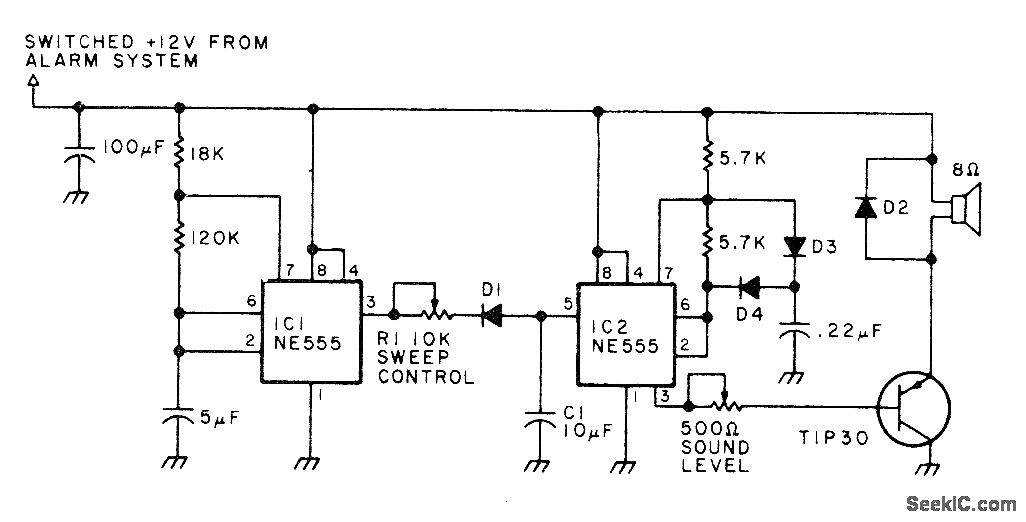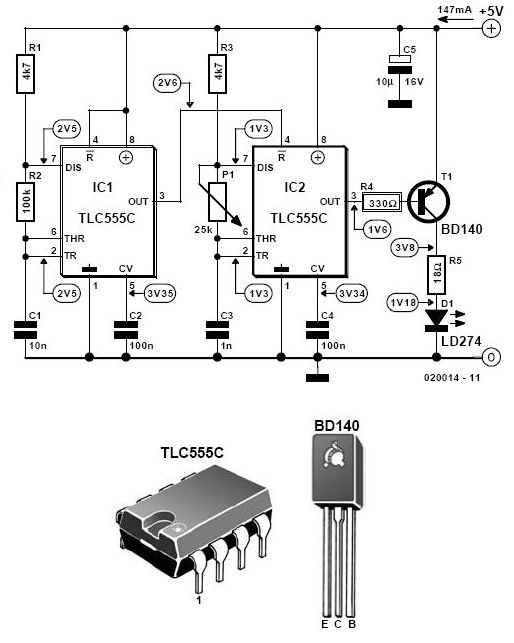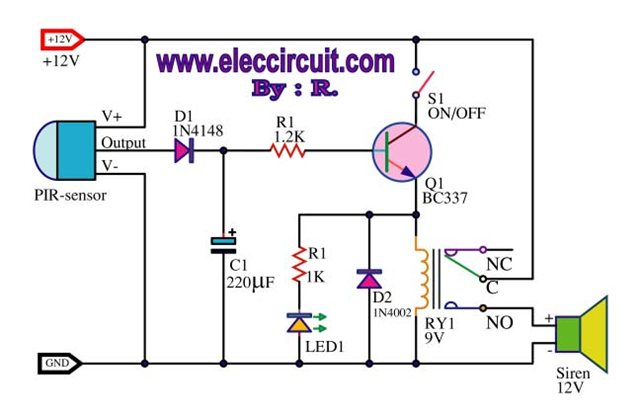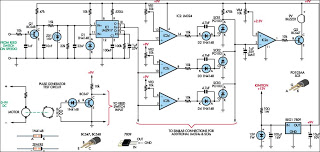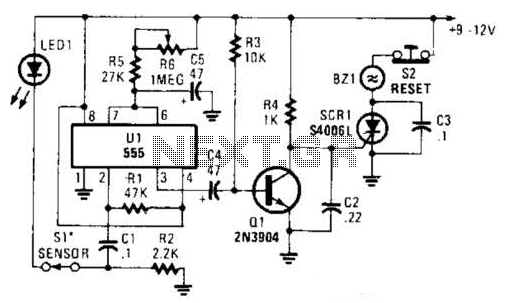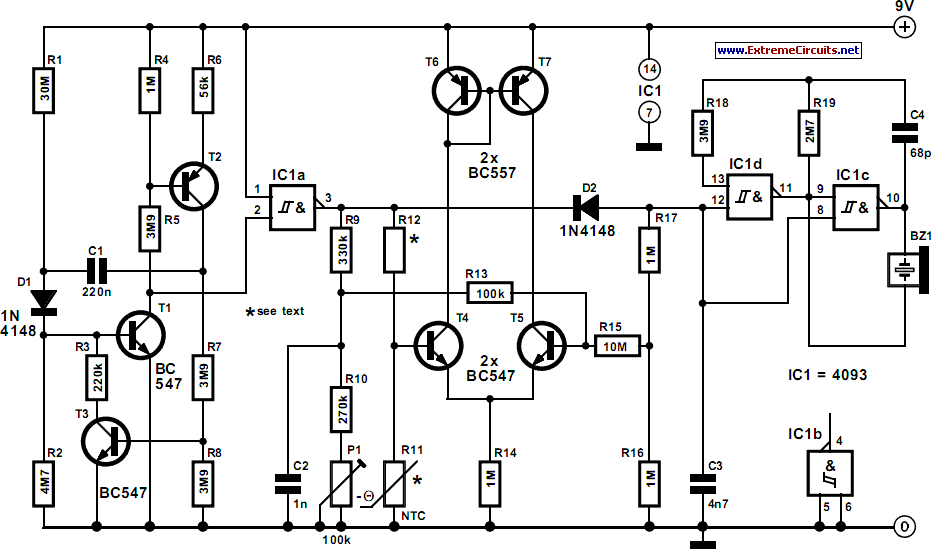
Speed Alarm For Cars
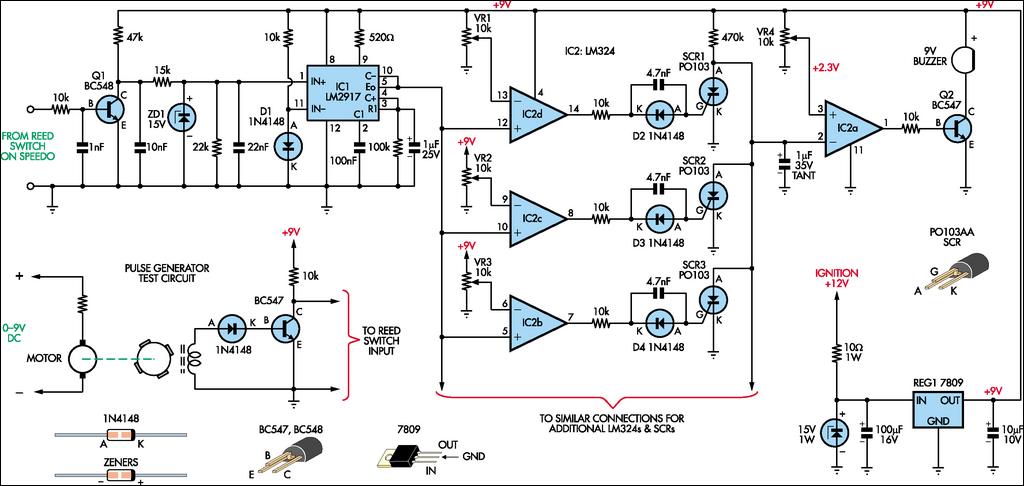
In normal suburban driving, passing through various speed zones can make it cumbersome to switch speed settings. The speed display may also serve as a distraction. This circuit removes the display and the need for speed selection altogether. Each time a specific speed threshold is exceeded (e.g., 40 km/h, 50 km/h), a piezo buzzer emits a beep. Speed pulses are sent to the base of transistor Q1, and the resulting waveform at its collector is processed through an RC network to the input of an LM2917 frequency-to-voltage converter, designated as IC1. The output voltage from IC1 is then directed to three comparators (IC2d-IC2b), which have their reference voltages set by 10-turn trimpots VR1, VR2, and VR3 at the inverting inputs. The output from each comparator is routed through another RC network to the gate of a silicon-controlled rectifier (SCR). The anodes of the three SCRs are connected to the inverting input of a remaining comparator, IC2a. The non-inverting input of IC2a is set to +2.3V using trimpot VR4. When the speed exceeds the threshold for a specific comparator, the corresponding SCR conducts briefly, pulling pin 2 of IC2a low, which triggers a short beep from the piezo buzzer. As the speed increases beyond the next threshold, an additional beep will sound. The design ensures that each speed setting is slightly above the actual speed limit, allowing the driver to maintain the correct speed without triggering the buzzer. As speed increases, the buzzer will beep once for each exceeded speed threshold, eliminating the need for constant adjustment of speed settings while driving through different zones and allowing the driver to disregard beeps that are not indicative of illegal speeds.
This circuit functions as a speed alert system by utilizing a combination of components to monitor vehicle speed and provide audio feedback without the need for visual displays. The LM2917 frequency-to-voltage converter serves as the central processing unit, converting frequency signals from the speed sensor into a proportional voltage. This voltage is compared against preset thresholds defined by the trimpots, allowing for fine-tuning of the speed limits.
Transistor Q1 acts as an amplifier, ensuring that the speed pulses are adequately processed before being sent to the LM2917. The RC networks serve to filter and smooth the signals, providing stable input to the comparators. The SCRs act as electronic switches that momentarily conduct when their respective thresholds are exceeded, providing a clear and immediate response to the driver.
The use of trimpots allows for customization of the speed thresholds, accommodating different driving conditions or personal preferences. By setting the thresholds slightly above the actual speed limits, the circuit minimizes false alerts while ensuring that the driver is informed if they exceed safe speeds.
Overall, this circuit offers a practical solution to the challenges of speed monitoring in suburban driving, enhancing safety and convenience without the distractions of traditional speed displays.In normal suburban driving you pass through so many different speed zones that it can be a nuisance having to switch speed settings. The speed display can also be a distraction. This circuit eliminates the display and the need for speed selection. Each time you exceed a particular speed setting (eg, 40km/h, 50km/h, etc), a piezo buzzer will beep. Speed pulses are fed to the base of Q1 and the resulting waveform at its collector is fed via an RC network to the input of an LM2917 frequency-to-voltage converter, IC1. The resulting voltage is fed to three comparators (IC2d-IC2b) which have the reference voltages at their inverting inputs set by 10-turn trimpots VR1, VR2 & VR3.
The output of each comparator is applied via another RC network to the gate of an SCR. The anodes of the three SCRs are commoned connected to the inverting input of the remaining comparator, IC2a. Its non-inverting input is set to +2. 3V by trimpot VR4. In use, once you exceed the speed setting for a particular comparator, its associated SCR briefly conducts to pull pin 2 of IC2a low and a short beep is emitted by the piezo buzzer.
Then, as you exceed the next speed setting, another beep will be heard. The idea is make each speed setting a few km/h higher than actual so that if you are driving at the correct speed in a given zone, the buzzer will not sound. But as you increase speed, the buzzer will beep once as you exceed the speed setting for each zone. In this way, there is no need to continually switch speed settings as you drive through different zones and you can choose to ignore beeps that are not "illegal".
🔗 External reference
This circuit functions as a speed alert system by utilizing a combination of components to monitor vehicle speed and provide audio feedback without the need for visual displays. The LM2917 frequency-to-voltage converter serves as the central processing unit, converting frequency signals from the speed sensor into a proportional voltage. This voltage is compared against preset thresholds defined by the trimpots, allowing for fine-tuning of the speed limits.
Transistor Q1 acts as an amplifier, ensuring that the speed pulses are adequately processed before being sent to the LM2917. The RC networks serve to filter and smooth the signals, providing stable input to the comparators. The SCRs act as electronic switches that momentarily conduct when their respective thresholds are exceeded, providing a clear and immediate response to the driver.
The use of trimpots allows for customization of the speed thresholds, accommodating different driving conditions or personal preferences. By setting the thresholds slightly above the actual speed limits, the circuit minimizes false alerts while ensuring that the driver is informed if they exceed safe speeds.
Overall, this circuit offers a practical solution to the challenges of speed monitoring in suburban driving, enhancing safety and convenience without the distractions of traditional speed displays.In normal suburban driving you pass through so many different speed zones that it can be a nuisance having to switch speed settings. The speed display can also be a distraction. This circuit eliminates the display and the need for speed selection. Each time you exceed a particular speed setting (eg, 40km/h, 50km/h, etc), a piezo buzzer will beep. Speed pulses are fed to the base of Q1 and the resulting waveform at its collector is fed via an RC network to the input of an LM2917 frequency-to-voltage converter, IC1. The resulting voltage is fed to three comparators (IC2d-IC2b) which have the reference voltages at their inverting inputs set by 10-turn trimpots VR1, VR2 & VR3.
The output of each comparator is applied via another RC network to the gate of an SCR. The anodes of the three SCRs are commoned connected to the inverting input of the remaining comparator, IC2a. Its non-inverting input is set to +2. 3V by trimpot VR4. In use, once you exceed the speed setting for a particular comparator, its associated SCR briefly conducts to pull pin 2 of IC2a low and a short beep is emitted by the piezo buzzer.
Then, as you exceed the next speed setting, another beep will be heard. The idea is make each speed setting a few km/h higher than actual so that if you are driving at the correct speed in a given zone, the buzzer will not sound. But as you increase speed, the buzzer will beep once as you exceed the speed setting for each zone. In this way, there is no need to continually switch speed settings as you drive through different zones and you can choose to ignore beeps that are not "illegal".
🔗 External reference
